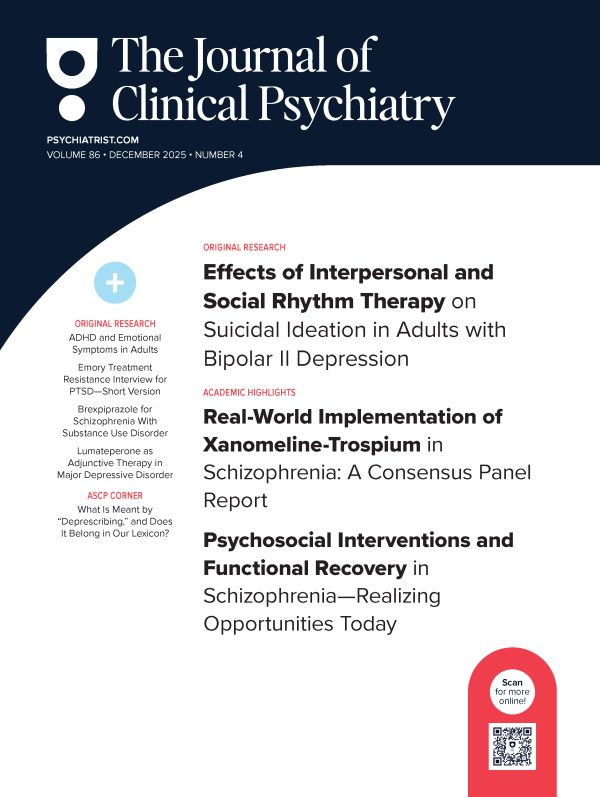Schizophrenia, 3rd ed
This large and comprehensive compendium of research and clinical findings pertaining to schizophrenia represents the contributions of a total of 71 coauthors, including the 2 editors, in a total of 33 chapters (7 new, and 11 replaced since the previous edition), covering virtually every aspect of the topic. The contributing authors and editors constitute an international list of "who’s who" in contemporary schizophrenia research. The original leadership of this massive undertaking was provided by my expatriate medical school classmate, Professor Steven Hirsch, MD, of London, whose position as co-editor is continued by Professor Paul Harrison of Oxford University. This, the third edition, was completed in early 2011.
Each of the 33 chapters includes an introductory outline, text divided into subsections, paragraphs on conclusions, and an abundant bibliography to support most data-based statements. There is also a detailed and vitally important, 22-page index. Chapters are divided into 4 major subdivisions: Descriptive Aspects (8 chapters, including extensive material on epidemiology), Biological Aspects (14 chapters, including extensive consideration of classic and molecular genetics and modern brain imaging), Physical Treatments (6 chapters), and Psychosocial Aspects (5 chapters).
Early chapters on Physical Aspects acknowledge the breadth and complexity of the century-old concept of "schizophrenia" and its basis in descriptions of signs, symptoms, and course—all of which vary and overlap other major psychiatric disorders. The schizophrenia concept arose from late 19th-century and early 20th-century efforts to divide the broad category of psychotic or otherwise severe and disabling psychiatric disorders into 2 major categories. These have evolved as disorders with mainly cognitive, delusional, hallucinatory, and "negative" symptoms and a generally chronic course (Kraepelin’s dementia prצcox and later Bleuler’s schizophrenia) versus those with largely episodic affective and behavioral symptoms and a relatively favorable prognosis (Kraepelin’s manic-depressive illness and DSM‘s type I bipolar disorder). However, even Kraepelin in his later years acknowledged that many, if not most, patients he had encountered in psychiatric institutions did not fit neatly into either his dementia prצcox or manic-depressive illness concepts.1 Such complexity and the lack of reliable and objective means of verifying the diagnosis lead to what can be considered a "phenotype problem." That is, basic heterogeneity associated with the concept of schizophrenia surely complicates and limits potential advances based on modern neurobiological or descriptive methods of study.2
Consideration of Biological Aspects of schizophrenia accounts for the largest proportion of material presented (45% of text pages) and reflects the longstanding interests and important contributions of the editors. This section includes chapters covering genetics, neuropathology, electrophysiology, structural and functional brain imaging (with a strong emphasis on the possible contributions of dysfunctions in the prefrontal cerebral cortex), neurodevelopment, and the possible roles of dopaminergic, glutamatergic, and GABAergic synaptic neurotransmission as well as a chapter on animal models. These reviews, as those found throughout the book, are scholarly, comprehensive, and appropriately cautious and tentative. At the same time, they reflect major advances in modern neurobiology and suggest common themes and interactions among the various approaches and applications of technological innovations for research. There is also an indication of a growing appreciation of the fundamental importance of comparisons among disorders, and not only of persons diagnosed with schizophrenia versus healthy controls, as the search for disorder-specific abnormalities continues.
The section on Physical Treatments is almost entirely a series of thorough and authoritative reviews of the pharmacology and clinical therapeutics of drugs with "antipsychotic" effects. The section includes helpful, though largely pharmacologically oriented, consideration of the very common problem of unsatisfactory responses to available medicinal treatments. Whole chapters are devoted to adverse neurologic and metabolic effects of antipsychotic drugs. More might have been said about the lack of specificity of this class of treatments and the failure of partial understanding of their pharmacodynamics to serve as leads to pathophysiology or etiology. Moreover, their severely limited efficacy in improving core features of schizophrenia other than relatively acute agitation, hallucinations, and delusions, as well as a lack of innovative principles with which to develop improved treatments might have been given greater emphasis.
The final section on Psychosocial Aspects of schizophrenia addresses psychological and social stressors contributing to and resulting from the disorder, mental health services, long-term outcomes, psychological treatments, and economics. It is much to the credit of the editors and authors that such clinically essential topics were included in a compendium heavily weighted toward biology and pharmacology.
Overall, this book represents a highly systematic, comprehensive, scholarly, and critical appraisal of a core component of modern psychiatry and a major public health challenge. It ably summarizes and evaluates efforts to better understand the nature, diagnosis, biology, psychology, sociology, and clinical treatment of the group of largely "nonaffective" psychotic disorders currently considered within the nosological domain of schizophrenia. As such, it is an essential volume for students, researchers, clinicians, and administrators interested in improved understanding and care of persons diagnosed with psychotic disorders.
References
1. Trede K, Salvatore P, Baethge C, et al. Manic-depressive illness: evolution in Kraepelin’s Textbook, 1883-1926. Harv Rev Psychiatry. 2005;13(3):155-178. doi:10.1080/10673220500174833 PubMed
2. Baldessarini RJ. American biological psychiatry and psychopharmacology 1944-1994. In: Menninger RW, Nemiah JC, eds. American Psychiatry After World War II (1944-1994), A Volume Celebrating the 150th Anniversary of the Founding of the American Psychiatric Association. Washington, DC: American Psychiatric Press; 2000:371-412.
Author affiliation: Harvard Medical School and McLean Hospital, Boston, Massachusetts.
Potential conflicts of interest: None reported.
Funding/support: Bruce J. Anderson Foundation and the McLean Private Donors Research Fund.
doi:10.4088/JCP.12bk07940
© Copyright 2012 Physicians Postgraduate Press, Inc.


